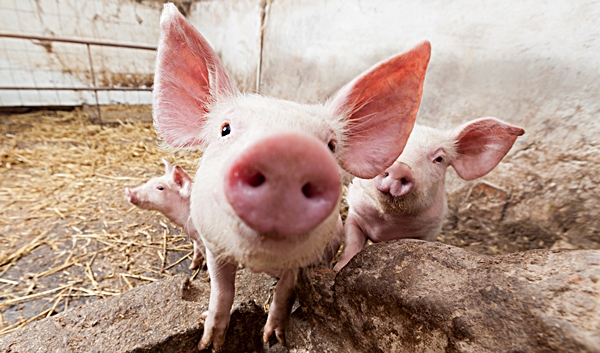Congress wants you to pay for farmers’ high-speed Internet

RURAL PORK?: The federal Farm Bill includes a provision that establishes a $10 million per year Gigabit Internet pilot program within the United States Department of Agriculture’s Rural Utilities Service’s broadband program
By Josh Peterson | Watchdog.org
WASHINGTON, D.C. — Contained in a bill at the center of the federal food stamp debate is a provision that would fund a five-year build out of high speed Internet networks to select rural communities.
The House of Representatives earlier this week passed after a two-year battle the Agricultural Act of 2014 — otherwise known as the Farm Bill — by a 251-166 bipartisan vote. The Senate could vote on its version the bill as early as next Tuesday.
The bill, which would fund farm subsidies for the next five-years, includes a provision that establishes a $10 million per year Gigabit Internet pilot program within the United States Department of Agriculture‘s Rural Utilities Service‘s broadband program.
The new USDA RUS pilot program would fund the development of as many as five rural high-speed networks during the next five years.
RUS did not return Watchdog.org’s request for comment by the time of publication.
Gigabit Internet speeds are at least 100 times faster than most high-speed Internet connections currently available to consumers, allowing households and businesses to do more on the Internet at faster speeds. Google‘s Google Fiber service in Kansas City, and Provo, Utah, is one example of a gigabit Internet service.
Policy experts fear a growing digital divide between rural and urban communities will leave farmers and other small business owners in rural communities, as well as their children, technologically behind the rest of the country and the rest of the world, increasing gaps in the nation’s economic inequality.
R.J. Karney, director of congressional relations for the American Farm Bureau Federation, a top agriculture industry lobby group, told Watchdog.org that farmers and ranchers rely on information available on the Internet to compete in what has become an international marketplace.
“They are running a small business, and they need to be able to function like a small business,” said Karney.
For example, Karney explained, farmers and ranchers who are connected to the Internet use it to know when they should sell crops and livestock.
The USDA reported in August 2011 that 62 percent of U.S. farmers have access to the Internet. In August 2013, the department reported that 35 percent of farmers were using DSL connections, while 5 percent were still using slower dial-up Internet.
“The Internet is past the luxury phase,” said he, emphasizing its importance to American small businesses. “It’s part of every day life.”
The speed of technological change also was a concern for Karney, explaining the need for a long-term solution.
“Farmers and ranchers don’t want to have one speed, but then in five to 10 years they’re left in the dark again,” said Karney.
High speed Internet also was important for rural hospitals and schools, he said.
When voicing concerns about the urban-rural digital divide, Internet service providers also commonly talk about the high costs of connecting rural communities.
David Carle, spokesman for Vermont Democrat U.S. Sen. Patrick Leahy, stressed to Watchdog.org, however, that private sector investment was not adequately addressing the issue.
Leahy championed the amendment to the Senate’s Farm Bill that would establish the pilot program.
“The Farm Bill reformed USDA’s rural access broadband loan program to focus on rural areas that don’t already meet a minimum level of broadband service,” said Carle in an email response to Watchdog.org.
“These are rural areas that already are running well behind the rest of the country,” said Carle. ”So it hasn’t seemed that private investment alone is getting that job done.”
The benefits of government investment in the broadband market, however, are debatable.
Watchdog.org has reported on numerous failed government-funded broadband projects affecting communities in Minnesota and Tennessee that are costing taxpayers millions of dollars.
But for smaller companies looking to build high-speed Internet networks, government funding is an attractive option.
TDS Telecommunications Corp., for example, received 44 different RUS awards under the American Recovery and Reinvestment Act of 2009.
The company is boasting 13 completed projects and expects to have all but one completed between March and April. TDS’ project in Arizona is expected to be completed by the end of the year, ahead of RUS’ June 2015 deadline.
“As a telecommunications provider focused on reliability, we applied for and received RUS broadband stimulus grants from the USDA to fortify our existing network and local exchange areas with fiber-optic and electronic networking gear capable of providing high-speed Internet access,” TDS spokesperson Cindy Tomilson said in an email response to Watchdog.org.
“We maintain the technicians, field services staff and network engineers skilled in the telecommunications industry sector,” said Tomilson. ”Applying for these grants was the market solution that was most cost effective, forward-looking and appropriate for our customers, our employees and our communities.”
Robert Steurer, spokesman for Senate Minority Leader Mitch McConnell, told Watchdog.org that he expects the Farm Bill to pass through the Senate intact.
Contact Josh Peterson at jpeterson@watchdog.org. Follow Josh on Twitter at @jdpeterson
The post Congress wants you to pay for farmers’ high-speed Internet appeared first on Watchdog.org.







